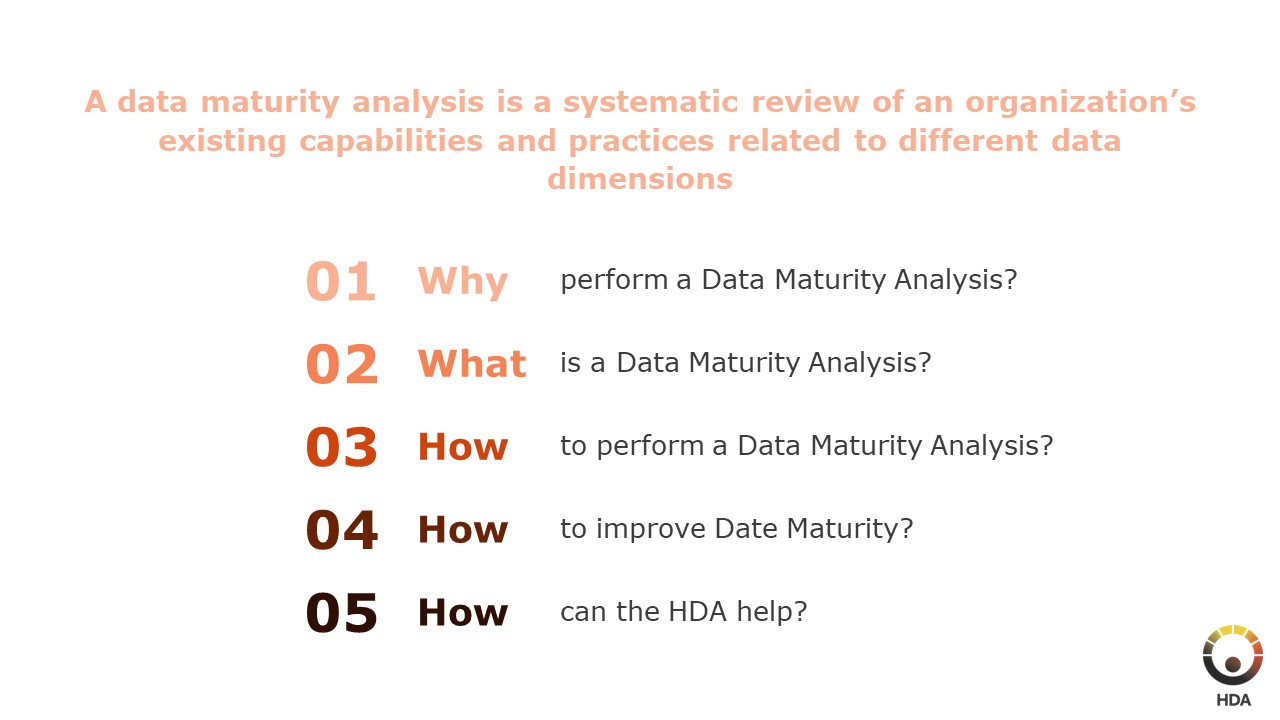Data maturity analysis
Topic outline
-
-
This course empowers public healthcare organizations and individuals engaged with data to understand and implement mature data governance, data management and data usage practices. Participants will grasp the significance of data maturity, learn to analyse and enhance it through a Data Maturity Analysis (DMA), and recognize the value of such analysis for organizational success. By the end of this course, you will be capable of selecting the data dimensions relevant to your organisation, strategically approaching data maturity, and leveraging support from the Health Data Agency.
Following topics will be displayed in the subsections:

-
-
In our contemporary, data-driven world, managing (health) data as a strategic asset is essential for the success of the healthcare industry and improvement of our health care system.
Navigating the complexities of data utilization and data management requires a deliberate and informed approach. Initiating this journey begins with a Data Maturity Analysis. This analysis not only reveals your organization's current status but also lays the groundwork for unlocking the full potential of data, fostering innovation, and ensuring your data practices align with overarching business objectives.
Why Undertake a Data Maturity Analysis?
- Gain a comprehensive understanding of your current maturity level in handling health data.
- Establish a Baseline of Strengths and Weaknesses in managing and utilizing health data.
- Align your data practices with overarching organizational goals and objectives.
- Use the analysis as a foundational step for crafting robust data strategies.
- Spot Areas for Improvement. The analysis serves as a diagnostic tool, enabling targeted enhancements.
- Facilitate Prioritization of Efforts. A targeted approach ensures that resources are allocated where they are most needed, optimizing the impact of your data management and usage initiatives.
Embark on the journey to data maturity, leveraging the insights provided by a Data Maturity Analysis to propel your healthcare organization toward excellence in data management and utilization. This commitment transcends organizational growth, it's a pledge to advance healthcare. Through responsible health data use, we chart a course toward a future defined by innovation, collaboration, and improved health outcomes for all.
-
-
-
A data maturity analysis is a systematic review of an organization’s existing capabilities and practices related to different data dimensions.
In the next visual, we will deep dive into the 9 dimensions.
In our methodology, the 9 dimensions are further divided into different metrics. The metrics for each dimension are indicated in the detailed description.
-
-
-
A Data Maturity Analysis is done in 6 steps:

The framework used for the data maturity assessment is based on proven methodologies (data4sdg, DAMA DMBoK,…) combined with health sector specific contextualisation such as standards and regulatory requirements.
-
The outcome of a data maturity analysis is typically expressed as a Current maturity level for the organization. This level represents the organization's proficiency and sophistication in managing and leveraging its data assets. The data maturity level is an indication of how well an organization understands, values, and utilizes its data throughout various processes and functions. Below we demonstrate the five levels:

-
-
-
Once you have conducted a thorough analysis of data maturity, your organization has valuable insights into its Current state.
Now, as we transition to the critical phase of formulating ambitions in the form of a Desired state. This phase is integral to laying the groundwork for future success. The emphasis shifts to setting realistic goals that align with the organization's capabilities and priorities. By aligning data-related goals with broader strategic objectives, a unified and harmonious approach is ensured, fostering organizational coherence. Key to this phase is the clear communication of the organization's data strategy and vision. This communication, supported by effective governance structures, ensures that all stakeholders are aligned with the overarching goals. Finally, a careful evaluation of the expected Return on Investment (ROI) should be set. This financial perspective adds a pragmatic dimension to the formulation process, enhancing the feasibility of your set objectives.
When the Current State and Desired State are known it becomes a matter of finding ways of Bridging the Gap and Moving Forward.

For example : In the 'Data Culture & Literacy' dimension, our methodology evaluates maturity through key metrics such as Training, Knowledge Sharing, and Organizational Commitment, illustrating the journey from the current state towards the desired state by bridging gaps in these areas. Once the focus of closing the gaps shifts from planning to execution, the ambitions are translated into tangible actions, strategically designed to elevate the organization's data maturity level.
Once the focus of closing the gaps shifts from planning to execution, the ambitions are translated into tangible actions, strategically designed to elevate the organization's data maturity level.
- Role Adjustments and Introductions: Identify and adapt roles strategically. This may involve introducing new roles or functions with specific data-related responsibilities or adjusting existing roles to accommodate evolving needs.
- Assessment of Resources: Building on the data maturity analysis, delve into a comprehensive assessment of available resources, including human capital and investments. This evaluation serves as the cornerstone for crafting ambitions that are not only aspirational but also attainable.
- Implementation of Data Management Processes: Concrete actions include establishing robust data management processes across the organization. This ensures consistency and efficiency in handling data throughout its lifecycle.
- Enhancing Data Transparency: Increase transparency surrounding data within the organization. This step is crucial for building trust and facilitating informed decision-making. Actions to enhance data visibility contribute to a culture of openness.
- Other Actionable Steps: Tailor additional necessary actions according to the specific context and requirements. This holistic approach ensures a comprehensive strategy for closing the gap and progressing toward desired data maturity levels.
Those recommendations are always tailored to your organisation’s strategic ambitions, priorities and available resources. In essence, these guidelines form a cohesive bridge from the analysis phase to the practical implementation of ambitions, steering the organization toward a realistic and actionable path in its journey to enhance data-related objectives.
-
-
-
-
-
You can take 2 minutes to answer a brief course feedback survey. Your insights are valuable in guiding our efforts to enhance course quality. Thank you for your participation!
-

